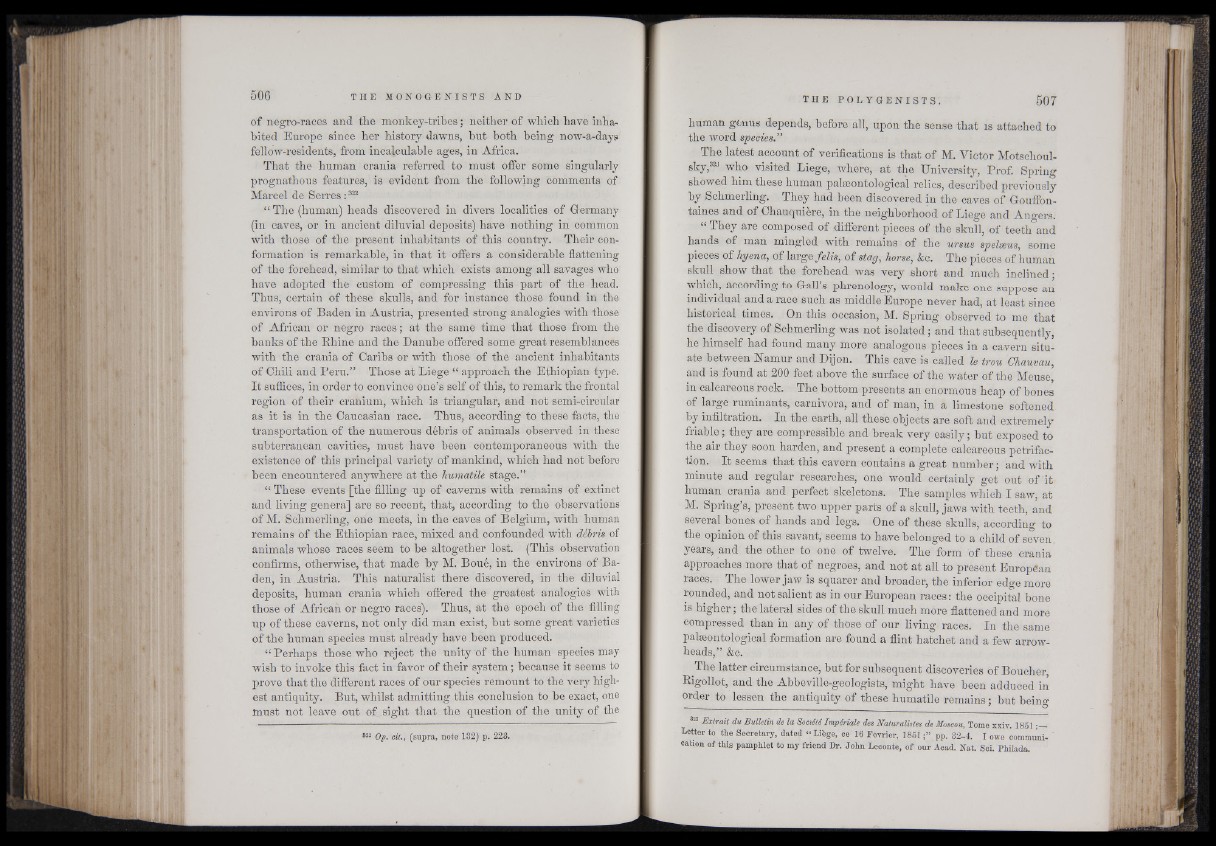
of negro-races and the monkey-tribes; neither of which have inhabited
Europe since her history dawns, hut both being now-a-days
fellow-residents, from, incalculable ages, in Africa.
That the human crania referred to must offer some singularly
prognathous features, is evident from the following comments of
Marcel de Serres:322
“ The (human) heads discovered in divers localities of Germany
(in caves, or in ancient diluvial deposits) have nothing in common
with those of the present inhabitants of this country. Their conformation
is remarkable, in that it offers a considerable flattening
of the forehead, similar to that which exists among all savages who
have adopted the custom of compressing this part of the head.
Thus, certain of these skulls, and for instance those found in the
environs of Baden in Austria, presented strong analogies with those
of African or negro races; at the same time that those from the
banks of the Rhine and the Danube offered some great resemblances
with the crania of Caribs or with those of the ancient inhabitants
of Chili and Peru.” Those at Liege “ approach the Ethiopian type.
It suffices, in order to convince one’s self of this, to remark the frontal
region of their cranium, which is triangular, and not semi-circular
as it is in the Caucasian race. Thus, according to these facts, the
transportation of the numerous débris of animals observed in these
subterranean cavities, must have been contemporaneous with the
existence of this principal variety of mankind, which had not before
been encountered anywhere at the humatile stage.”
“ These events [the filling up of caverns with remains of extinct
and living genera] are so recent, that, according to the observations
of M. Schmerling, one meets, in the caves of Belgium, with human
remains of the Ethiopian race, mixed and confounded with debris of
animals whose races seem to be altogether lost. (This observation
confirms, otherwise, that made by M. Boué, in the environs of Baden,
in Austria. This naturalist there discovered, in the diluvial
deposits, human crania which offered the greatest analogies with
those of African or negro races). Thus, at the epoch of the filling
up of these caverns, not only did man exist, but some great varieties
of the human species must already have been produced.
“ Perhaps those who reject the unity of the human species may
wish to invoke this fact in favor of their system; because it seems to
prove that the different races of our species remount to the very highest
antiquity. But, whilst admitting this conclusion to be exact, one
must not leave out of.sight that the question of the unity of the
822 Opt cii'} (supra, note 132) p. 223.
human genus depends, before all, upon the sense that is attached to
the word species.”
The latest account of verifications is that of M. Yietor Motsehoul-
sky,333 who visited Liege, where, at the University, Prof. Spring
showed him these human palaeontological relics, described previously
by Schmerling. They had been discovered in the caves of Gouffon-
taines and of Ohauquière, in the neighborhood of Liege and Angers.
“ They are composed of different pieces of the skull, of teeth and
hands of man mingled with remains of the ursus spelseus, some
pieces of hyena, of large felis, of stag, horse, &c. The pieces of human
skull show that the forehead was very short and much inclined ;
which, according to Gall s phrenology, would make one suppose an
individual and a race such as middle Europe never had, at least since
historical times. On this occasion, M. Spring observed to me that
the discovery of Schmerling was not isolated ; and that subsequently,
he himself had found many more analogous pieces in a cavern situate
between Eamur and Dijon. This cave is called le trou Chauvau,
and is found at 200 feet above the surface of the water of the Meuse,
in calcareous rock. The bottom presents an enormous heap of bones
of large ruminants, carnivora, and of man, in a limestone softened
by infiltration. In the earth, all these objects are soft and extremely
friable ; they are compressible and break very easily ; but exposed to
the air they soon harden, and present a complete calcareous petrifaction.
It seems that this cavern contains a great number ; and with
minute and regular researches, one would certainly get out of it
human crania and perfect skeletons. The samples which I saw, at
M. Spring’s, present two upper parts of a skull, jaws with teeth, and
several bones of hands and legs. One of these skulls, according to
the opinion of this savant, seems to have belonged to a child of seven
years, and the other to one of twelve. The form of these crania
approaches more that of negroes, and not at all to present European
races. The lower jaw is squarer and broader, the inferior edge more
rounded, and not salient as in our European races: the occipital hone
is higher ; the lateral sides of the skull much more flattened and more
compressed than in any of those of our living races. In the same
palaeontological formation are found a flint hatchet and a few arrowheads,”
&c.
The latter circumstance, but for subsequent discoveries of Boucher
Rigollot, and the Abbeville-geologists, might have been adduced in
order to lessen the antiquity of these humatile remains : but beine-
__________________________________________________ 7 O
823 Extrait du Bulletin de la Société Impériale des Naturalistes de Moscou, Tome xxiv. 1851 •__
Letter to the Secretary, dated “ Liège, ce 16 Février, 1851 pp. 32-4. I owe commJni- '
cation of this pamphlet to my friend Dr. John Leconte, of our Acad. Nat. Sci. Philada.